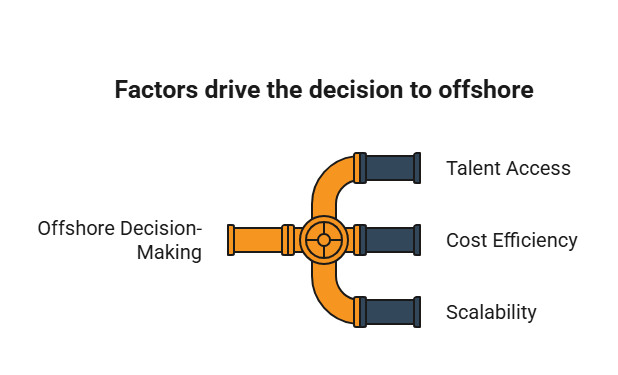- Introduction
- What Is Offshoring in Software Development?
- Why Are Australian Companies Offshoring Software Development?
- What Are the Benefits of Offshoring Software Development?
- What Are the Risks of Offshoring Software Projects — and How to Avoid Them?
- Which Countries Are Best for Offshoring Software Development?
- How Much Does It Cost to Offshore a Software Development Team?
- What Should You Look for in an Offshore Software Development Partner?
- How to Manage and Collaborate with an Offshore Team Successfully?
- Is Offshoring Right for Your Business? A Checklist for Decision-Makers
- How to Get Started with Offshoring Software Development the Right Way
- FAQs
The Australian tech industry faces a perfect storm
Demand for software developers has skyrocketed, but local talent remains scarce and expensive.
As a solution, many Australian businesses are exploring the offshore model to bridge this gap and meet their growing needs.
But offshoring isn’t just about cutting costs anymore. It’s become a strategic move that lets companies access global talent pools, scale faster, and focus on core business activities while maintaining high quality.
Whether you’re a startup looking to build your first app, this guide is for you. If you’re an established company wanting to expand your development capacity, you’ll find value here too.
This comprehensive overview will help you make informed decisions about offshore software development companies.
What Is Offshoring in Software Development?
Offshoring software development means hiring developers or development teams located in different countries to build your software products.
These offshore teams work as an extension of your business, handling everything from web applications to mobile apps and enterprise software.
The key difference lies in geography. Offshoring specifically involves working with teams in different countries, often with significant time zone differences. This sets it apart from other models:
- Offshoring vs Outsourcing: Outsourcing can happen locally or internationally. Offshoring always involves crossing borders.
- Offshoring vs Remote Work: Remote work typically involves employees in the same country. Offshore teams are based internationally.
- Offshoring vs Nearshoring: Nearshoring involves countries in similar time zones or regions. Offshoring often spans continents.
- Offshoring vs Freelancing: Freelancers work independently on specific tasks. Offshore teams integrate into your development process long-term.
For Australian businesses, popular offshoring destinations include the Philippines, Sri Lanka, and Eastern Europe. These regions offer skilled developers, competitive rates, and reasonable communication windows despite time zone challenges.
Why Are Australian Companies Offshoring Software Development?
Australia’s tech talent shortage has reached critical levels. The Australian Computer Society reports a shortage of over 60,000 ICT workers. This scarcity drives up local developer salaries and makes hiring extremely competitive.
The shift to remote work during COVID-19 changed everything. Australian businesses discovered they could collaborate effectively with distributed teams. This experience made offshoring feel less risky and more practical.
Three main factors drive the decision to offshore:
- Talent Access: Offshore markets offer access to developers with specialised skills that might be rare locally. Countries like the Philippines and Sri Lanka have strong education systems producing quality software engineers.
- Cost Efficiency: While not the only consideration, cost savings remain significant. Australian businesses can often hire 2-3 offshore developers for the price of one local hire.
- Scalability: Offshore development companies can quickly scale teams up or down based on project needs. This flexibility is particularly valuable for growing Australian businesses.
The remote-first mindset that emerged post-COVID made these benefits more accessible to Australian companies of all sizes.

What Are the Benefits of Offshoring Software Development?
Cost-Efficiency Without Compromising Quality
The biggest perk? Cutting costs. In Australia, developer salaries usually sit between $80,000 and $150,000 a year.
But hiring offshore developers from places like the Philippines or Sri Lanka can deliver high quality results at 40-60% lower costs compared to australian developers.
And it’s not just the salaries,you’ll save on admin too. Offshore teams take care of recruitment, HR, infrastructure, and managing the team, so you can focus on what really matters.
Access to Global Tech Talent
Offshore markets offer access to developers with diverse skill sets and experience levels. Many offshore developers have worked with international clients, bringing valuable perspectives to your projects.
Countries like Sri Lanka and the Philippines have strong English proficiency and cultural alignment with Western business practices. This makes communication smoother and reduces cultural friction.
This also opens up opportunities for 24-hour productivity by leveraging different time zones for real time communication when needed.
Faster Time-to-Market
Established offshore development companies can assemble experienced teams quickly. Instead of spending months recruiting locally, you can have a dedicated offshore developer team working within weeks.
Time zone differences can actually accelerate development. While your Australian team sleeps, offshore teams continue working. This creates a development cycle that approaches 24-hour productivity.
Focus on Core Business Activities
Offshoring routine development tasks lets your local team focus on what really matters.
Product managers can spend more time improving the user experience and nailing market fit, while offshore teams take care of the implementation.
Splitting the work this way often gets better results. Your local team stays connected to customers and business goals, while your offshore team handles the technical stuff efficiently. It’s a win-win!!
What Are the Risks of Offshoring Software Projects — and How to Avoid Them?
Communication Challenges
Different time zones can create communication barriers. Misunderstandings might not get resolved quickly, potentially affecting projects.
- Solution: Establish clear communication protocols. Use project management tools like Jira or Trello for asynchronous updates. Schedule regular overlap hours when both teams are online. Document requirements thoroughly and confirm understanding before work begins. Use effective communication channels and schedule overlapping hours for essential discussions.
Quality Control Issues
Without proper oversight, code quality might not meet your standards. Different development practices or shortcuts can create technical debt.
- Solution: Work with reputable offshore software development companies that prioritize accountability and use detailed project scope documentation.
Cultural and Time Zone Differences
Different work cultures and business practices can lead to misaligned expectations. Holiday schedules and working hours vary significantly between countries.
- Solution: Invest time in cultural understanding. Learn about your offshore team’s local customs and holidays. Be explicit about expectations and deadlines. Build buffer time into project schedules to accommodate time zone challenges.
Choosing the Right Partners
Selecting unreliable providers can lead to complications.
- Solution: Focus on choosing the right partners, considering their experience, expertise, and client reviews.
Which Countries Are Best for Offshoring Software Development?
Philippines
The Philippines has emerged as a top destination for Australian businesses offshoring software development. Filipino developers typically have strong English skills and cultural alignment with Western business practices.
- Strengths: Excellent English proficiency, similar time zones to Australia (2-3 hours difference), growing tech sector, competitive rates.
- Best For: Web development, mobile applications, customer-facing software requiring strong communication skills.
Sri Lanka
Sri Lanka offers a mature IT industry with experienced developers. The country has invested heavily in technology education and has a reputation for delivering quality software solutions.
- Strengths: High-quality developers, established IT infrastructure, cost-effective rates, strong government support for IT exports.
- Best For: Web development, mobile applications, Complex enterprise applications, fintech solutions, projects requiring experienced senior developers.
Eastern Europe
Countries like Poland, Ukraine, and Romania offer highly skilled developers with strong technical backgrounds. However, time zone differences with Australia can be challenging.
- Strengths: Excellent technical skills, strong educational systems, experience with complex projects.
- Best For: Advanced technical projects, when development expertise is more important than real-time collaboration.
For Australian businesses, the Philippines and Sri Lanka often provide the best balance of talent quality, cost-effectiveness, and manageable time zone differences.
To learn more about minimizing risks and ensuring a smooth hiring process, check out our guide on Risk-Free Offshore Hiring for Australian Recruiters.
How Much Does It Cost to Offshore a Software Development Team?
Australian senior developers typically cost $120,000-$150,000 annually, including benefits and overhead. Junior developers start around $70,000-$90,000.
Offshore rates vary by country and experience level:
- Philippines: $20,000-$45,000 annually for comparable skill levels
- Sri Lanka: $18,000-$40,000 annually for similar experience
- Eastern Europe: $30,000-$60,000 annually for equivalent expertise
These figures include the offshore development company’s margins but exclude your internal management costs.
Pricing Models
- Fixed Price: Best for well-defined projects with clear requirements. Provides cost certainty but less flexibility for changes.
- Time and Material: Pay for actual hours worked. Offers flexibility but requires active project management to control costs.
- Dedicated Team Model: Hire specific team members for extended periods. Provides consistency and integration with your processes while maintaining cost predictability.
Most successful long-term relationships use the dedicated team model. It provides the benefits of having permanent team members while maintaining the cost advantages of offshoring.
What Should You Look for in an Offshore Software Development Partner?
Technical Expertise and Experience
Look for offshore development companies with proven experience in your technology stack and industry. Check their portfolio for similar projects and complexity levels.
Ask about their developers’ certifications and ongoing training programs. The best offshore partners invest in keeping their team members current with evolving technologies.
Communication and Project Management
Strong communication processes are essential for successful offshore development. Look for companies that provide dedicated project managers and use standard project management tools.
Evaluate their English proficiency and cultural fit during initial conversations. Good offshore partners understand Western business practices and communication styles.
Security and Compliance
Ensure your offshore development company has proper security certifications. ISO 27001 certification indicates robust information security management systems.
For Australian businesses handling personal data, verify that offshore partners understand Australian privacy laws and can implement appropriate compliance measures.
Scalability and Team Structure
Choose partners who can scale teams up or down based on your needs. The best offshore development companies have deep talent pools and established recruitment processes.
Understanding their team structure helps set realistic expectations. Some companies use a mix of junior and senior developers, while others focus on specific experience levels.
How to Manage and Collaborate with an Offshore Team Successfully?
Essential Tools and Platforms
Successful offshore development relies heavily on the right collaboration tools. Project management platforms like Jira or Asana help track progress across time zones. Communication tools like Slack or Microsoft Teams enable quick discussions and file sharing.
Version control systems like Git ensure code collaboration works smoothly. Cloud-based development environments let offshore teams access the same tools and systems as local developers.
Agile Methodologies Across Time Zones
Agile offshore development requires adapting traditional practices for distributed teams. Daily stand-ups might become asynchronous updates due to time zone differences. Sprint planning sessions need careful scheduling to include all team members.
Documentation becomes more critical in offshore development. User stories, acceptance criteria, and technical specifications must be more detailed than typical co-located development.
Establishing Clear Processes
Define clear handoff procedures between your local team and offshore developers. Establish what information needs to be ready before offshore teams start their day.
Create escalation procedures for urgent issues. Sometimes problems can’t wait for the next overlapping work period. Having clear escalation paths prevents delays.
Building Team Culture
Invest in relationship building with your offshore development team. Regular video calls help build personal connections beyond work discussions. Celebrate project milestones and achievements together.
Consider occasional in-person meetings if budgets allow. Many Australian companies bring key offshore team members to Australia annually or send local team members to offshore locations.
Is Offshoring Right for Your Business? A Checklist for Decision-Makers
While offshoring provides numerous benefits, businesses must also anticipate the challenges of offshoring and collaborate with offshore software development companies that align well with their goals and priorities.
When Offshoring Makes Sense
- You have clear project requirements: Offshoring works best when you can articulate exactly what needs to be built. Vague or constantly changing requirements create challenges across time zones.
- You need to scale quickly: If you need to add development capacity faster than local hiring allows, offshore teams can be assembled within weeks rather than months.
- Cost is a significant factor: If development costs are constraining your growth or product development, offshoring can free up budget for other priorities.
- You have project management capacity: Successful offshoring requires active management. Ensure you have the internal resources to coordinate with offshore teams effectively.
When to Avoid Offshoring
- You’re in early product discovery: If you’re still figuring out what to build, the communication overhead of offshoring might slow down rapid iteration cycles.
- You need constant real-time collaboration: Some projects require continuous back-and-forth discussion. Time zone differences make this challenging with offshore teams.
- You have extremely tight deadlines: While offshore development can accelerate some projects, the initial setup and communication overhead might not suit urgent deadlines.
- Your project involves highly sensitive data: If you’re working with extremely confidential information, keeping development in-house might be worth the additional cost.
Making the Decision
Consider starting with a small pilot project to test the offshore development process. This lets you evaluate potential partners and refine your processes before committing to larger projects.
Calculate the total cost of ownership, including your internal management time. While offshore development reduces direct costs, it does require ongoing coordination effort.
How to Get Started with Offshoring Software Development the Right Way
The key to successful offshore software development lies in choosing the right partner and establishing clear processes from the beginning. Start by clearly defining your project requirements and success criteria.
Research potential offshore development companies thoroughly. Look for partners with proven experience in your industry and technology stack. Check references and review their security certifications.
Invest time in establishing clear communication protocols and project management processes. The effort you put into setup pays dividends throughout the development process.
Remember that successful offshoring is about building long-term partnerships, not just reducing costs. The best offshore relationships provide access to global talent while maintaining the quality and reliability your business needs.
Ready to explore how offshore software development can accelerate your business growth? Hire offshore software developers through Webco Talent and discover the benefits of working with experienced development teams in the Philippines and Sri Lanka.
FAQs
What is Offshoring Software Development?
Offshoring Software Development involves hiring developers or teams in other countries to build software. It helps businesses access global talent, reduce costs, and scale quickly.
Why do Australian businesses choose offshoring?
Australian businesses offshore to address local talent shortages, reduce costs, and access specialized skills. It also enables faster scaling and 24-hour productivity.
What are the risks of offshoring?
Risks include communication delays, quality control issues, and cultural differences. These can be mitigated with clear processes, robust tools, and reliable partners.
Which countries are best for offshoring?
Popular destinations include the Philippines, Sri Lanka, and Eastern Europe. These regions offer skilled developers, cost efficiency, and manageable time zone differences.
How much does offshoring cost?
Costs vary by country. For example, developers in the Philippines or Sri Lanka cost 40-60% less than Australian developers, depending on experience.
How do I start offshoring?
Start by defining project requirements, researching offshore partners, and beginning with a pilot project. Clear communication and robust management processes are essential.






